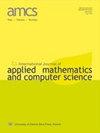混合动力无人潜航器的动态下潜运动模型:仿真与实验验证
IF 1.2
4区 计算机科学
Q3 AUTOMATION & CONTROL SYSTEMS
International Journal of Applied Mathematics and Computer Science
Pub Date : 2023-06-01
DOI:10.34768/amcs-2023-0016
引用次数: 0
摘要
水下航行器的混合推进是将螺旋推进器等传统推进系统与振动仿生鳍、滑翔机翼或喷气推进器等其他推进系统相结合的新思路。每种推进系统都有自己的优点和缺点,目标是在特定条件下使它们相互补充。本文研究了采用螺旋螺旋桨和仿生侧鳍的混合型无人潜航器的俯仰运动和升沉运动动力学模型。首先,建立了车辆深度和俯仰变化的仿真模型。其次,对CFD模拟得到的飞行器水动力系数进行了讨论。第三,给出了HUUV在游泳池中的实验研究结果。最后,将仿真结果与实验结果进行了比较,验证了模型的正确性。实验期间,车辆在游泳池中的运动用水下摄像机记录下来,然后用Tracker软件进行分析。本文章由计算机程序翻译,如有差异,请以英文原文为准。
A Dynamic Submerging Motion Model of the Hybrid–Propelled Unmanned Underwater Vehicle: Simulation and Experimental Verification
Abstract Hybrid propulsion in underwater vehicles is the new idea of combining conventional propulsion systems such as screw propellers with other kinds of propulsion like oscillating biomimetic fins, glider wings or jet thrusters. Each of these propulsion systems has its own benefits and drawbacks, and the goal is to have them complement each other in certain conditions. This paper covers the topic of a dynamic model of the pitch and heave motion of the HUUV (hybrid unmanned underwater vehicle) using screw propellers and biomimetic lateral fins. Firstly, the simulation model of the vehicle performing depth and pitch change is presented. Secondly, the vehicle’s hydrodynamic coefficients obtained from CFD simulations are discussed. Thirdly, the results of the HUUV experimental studies in a swimming pool are presented. Lastly, simulation results are compared with those of the experiment to verify the correctness of the model. The vehicle’s motion in the swimming pool during the experiments was recorded using a submerged camcorder and then analysed using the Tracker software.
求助全文
通过发布文献求助,成功后即可免费获取论文全文。
去求助
来源期刊
CiteScore
4.10
自引率
21.10%
发文量
0
审稿时长
4.2 months
期刊介绍:
The International Journal of Applied Mathematics and Computer Science is a quarterly published in Poland since 1991 by the University of Zielona Góra in partnership with De Gruyter Poland (Sciendo) and Lubuskie Scientific Society, under the auspices of the Committee on Automatic Control and Robotics of the Polish Academy of Sciences.
The journal strives to meet the demand for the presentation of interdisciplinary research in various fields related to control theory, applied mathematics, scientific computing and computer science. In particular, it publishes high quality original research results in the following areas:
-modern control theory and practice-
artificial intelligence methods and their applications-
applied mathematics and mathematical optimisation techniques-
mathematical methods in engineering, computer science, and biology.

 求助内容:
求助内容: 应助结果提醒方式:
应助结果提醒方式:


